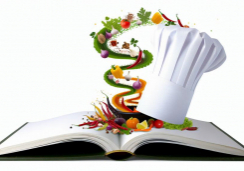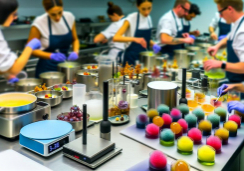Innovative Gluten-Free Baking Recipes Unveiled
Nearly one in a hundred people worldwide are now diagnosed with celiac disease, fueling a surge in demand for gluten-free products that don't compromise on taste or texture. You've likely noticed the influx of gluten-free options lining supermarket shelves, but perhaps you're still searching for that perfect homemade bread or decadent cake that doesn't crumble at the touch.
The new wave of innovative gluten-free baking recipes promises to transform your kitchen into a haven for those who can't tolerate gluten, offering a variety of treats that stand up to their wheat-based counterparts. As you explore these culinary creations, you'll uncover the secrets to replicating the elasticity and fluffiness often lost without gluten.
So, whether you're a seasoned gluten-free baker or just starting to navigate this new terrain, prepare to embark on a journey that could change your baking game forever.
Decoding Gluten-Free Flours
Understanding the diverse characteristics of gluten-free flours is essential for mastering their use in your baking endeavors. Almond flour, rich in protein and low in carbohydrates, provides a moist texture and nutty flavor, making it perfect for dense, grain-free baked goods. Coconut flour, highly absorbent with a mild sweetness, is packed with fiber and requires additional liquids in recipes to prevent dryness. Chickpea flour, also known as garbanzo bean flour, offers an earthy taste and is loaded with protein and fiber, contributing to hearty and nutritious creations.
In gluten-free baking, recognizing the role of binders like xanthan gum or psyllium husk powder can make or break the final product. These ingredients mimic gluten's structural properties, ensuring your baked goods have the desired consistency without falling apart. You'll often need to experiment with various combinations of gluten-free flours and binders to achieve the best results.
Learning to decode gluten-free flours not only allows you to adapt traditional recipes into delightful gluten-free versions but also empowers you to innovate with confidence. As you gain expertise, you'll find that crafting your unique flour blends opens up a new world of textures, flavors, and nutritious benefits in your gluten-free baking.
Mastering Xanthan and Guar Gums
Mastering the use of xanthan and guar gums can significantly enhance the texture and structure of your gluten-free baked goods, acting as vital substitutes for gluten's binding properties. These gums are essential for mimicking gluten's role in baking, providing the necessary elasticity and stickiness that gluten-free flours lack.
Xanthan gum, derived from the fermentation of sugars by Xanthomonas campestris, has a potent thickening ability even in small quantities. Typically, a quarter to half a teaspoon per cup of flour is sufficient to produce the desired consistency in most gluten-free recipes. On the other hand, guar gum, sourced from guar beans, may require a bit more to achieve similar results, as it tends to be less potent than xanthan gum.
Both xanthan and guar gums serve as binders and stabilizers, improving the texture of your baked items, preventing them from crumbling, and extending shelf life. They're crucial for creating a palatable mouthfeel and structural integrity in bread, cakes, and cookies.
To perfect your gluten-free baking, it's important to understand the right ratios and combinations of these gums. Experimenting with xanthan and guar gums will open up a world of possibilities, enabling you to produce a vast array of gluten-free goods with textures and structures that are truly appealing and satisfying.
Perfecting Gluten-Free Yeast Dough
Having grasped the essentials of xanthan and guar gums in gluten-free baking, let's now explore how to craft the perfect gluten-free yeast dough, a cornerstone for exquisite bread and pastries that don't compromise on taste or texture. Your success hinges on understanding the unique properties of gluten-free flours and their interaction with yeast. These flours lack gluten, which normally traps air and gives dough its stretch and chew. Xanthan gum steps in to mimic this elasticity, ensuring your dough rises beautifully.
Proper proofing and rising techniques are paramount. They allow the yeast to ferment, creating the gases that expand your dough, which results in that sought-after airy texture. It's a delicate balance, though, as too much rise can cause the structure to collapse, while too little will leave your dough dense.
Experimentation is your ally in achieving an even better texture. Each gluten-free flour brings a unique nutrient profile and absorbency rate, affecting hydration levels and the final product's tenderness. By adjusting the ratios and types of flours and hydration, you'll pinpoint the precise blend that yields a dough that's both chewy and tender, rivaling its gluten-containing counterparts.
How Can I Incorporate More Creativity into My Gluten-Free Baking?
Looking for inspiration to elevate your gluten-free baking? Get creative with unique flavor combinations and alternative ingredients in your glutenfree baking recipes. Experiment with different fruits, nuts, and spices to add a twist to your favorite recipes. Embrace the art of gluten-free baking and let your creativity shine in the kitchen.
Innovative Gluten-Free Sweeteners
Exploring innovative gluten-free sweeteners, such as honey, maple syrup, and agave nectar, can enhance the flavor profiles of your baked goods while adhering to dietary restrictions. These natural sweeteners, along with options like stevia and monk fruit, offer a plethora of benefits for your health-conscious recipes. They're not just about avoiding gluten; they're about infusing your treats with nuanced tastes and nutritional advantages.
- Honey: Rich and floral, it brings a touch of natural sweetness and a slight moistness to your creations.
- Maple Syrup: With its distinctive warm and woody notes, it's perfect for adding depth to your recipes.
- Agave Nectar: Its mild flavor and liquid form make it an excellent sweetener for smooth batters and doughs.
- Stevia: A zero-calorie sweetener that's much sweeter than sugar, so you'll need less, minimizing calorie count without sacrificing sweetness.
- Monk Fruit: Known for its intense sweetness and antioxidant properties, it's a healthful addition that doesn't spike blood sugar levels.
Each of these sweeteners brings more than just sweetness; they contribute antioxidants, vitamins, and minerals. They're a testament to the fact that gluten-free baking doesn't mean compromising on taste or health. By integrating these innovative sweeteners into your baking repertoire, you're not just following a trend – you're embracing a lifestyle that's both delicious and nutritious.
Exploring Dairy-Free Alternatives
You'll discover that incorporating dairy-free alternatives like almond milk, coconut milk, and oat milk into your baking not only caters to dietary needs but also introduces exciting new flavors and textures.
Almond milk, with its nutty undertone, can enhance the taste of your baked goods, while coconut milk adds a hint of tropical richness. Oat milk, often celebrated for its creaminess, can provide a soft, velvety texture, making it an excellent dairy substitute in cakes and muffins.
These dairy-free alternatives aren't just about avoiding lactose or dairy allergies; they're about enriching your culinary creations with diverse nutrients. Almond milk, for example, is a good source of vitamin E, an antioxidant that supports skin health. Coconut milk contains medium-chain triglycerides (MCTs), fats that may boost metabolism. Oat milk offers a dose of fiber and can be a heart-friendly option with its beta-glucans known to help with cholesterol management.
Embracing dairy-free alternatives in baking means you're not compromising on taste or texture. Instead, you're making your treats accessible to more people while experimenting with ingredients that could make your recipes stand out.
Conclusion
You've now explored the art of gluten-free baking, mastering flours, gums, and yeast doughs, while innovating with sweeteners and dairy alternatives. Armed with this knowledge, you can create nutritious, delectable treats that nourish and delight.
Remember, each recipe is a step towards a stronger, inclusive community. Dive into 'Innovative Gluten-Free Baking Recipes Unveiled,' and let your culinary creativity flourish, confident in the health benefits of every mouthwatering bite.
Happy baking!










